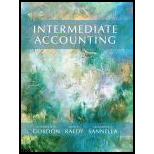
Intermediate Accounting
1st Edition
ISBN: 9780132162302
Author: Elizabeth A. Gordon, Jana S. Raedy, Alexander J. Sannella
Publisher: PEARSON
expand_more
expand_more
format_list_bulleted
Concept explainers
Question
Chapter 7, Problem 7.20E
To determine
The expected cash flows in the given scenarios and their comparison.
Expert Solution & Answer
Want to see the full answer?
Check out a sample textbook solution
Students have asked these similar questions
Need help this question general accounting
calculate the total contribution margin, contribution margin per unit , and contribution margin percentage ??
I need help with this financial accounting question using standard accounting techniques.
Chapter 7 Solutions
Intermediate Accounting
Ch. 7 - Prob. 7.1QCh. 7 - Prob. 7.2QCh. 7 - If interest is compounded more than once a year,...Ch. 7 - Prob. 7.4QCh. 7 - Can an ordinary annuity table be used to determine...Ch. 7 - Prob. 7.6QCh. 7 - Is the present value of an ordinary annuity more...Ch. 7 - Prob. 7.8QCh. 7 - Simple Interest. Assume Shafer Corporation...Ch. 7 - Compound Interest. Assume Shafer Corporation...
Ch. 7 - Prob. 7.3BECh. 7 - Prob. 7.4BECh. 7 - Prob. 7.5BECh. 7 - Present Value of a Single Sum, Compound Interest....Ch. 7 - Future Value of a Single Sum, Compound Interest....Ch. 7 - Prob. 7.8BECh. 7 - Present Value of a Single Sum, Compounded Interest...Ch. 7 - Prob. 7.10BECh. 7 - Present Value of a Single Sum, Calculating Time...Ch. 7 - Future Value of an Ordinary Annuity. An...Ch. 7 - Future Value of an Annuity Due. Mariah Carey...Ch. 7 - Future Value of an Ordinary Annuity: Calculating...Ch. 7 - Present Value of an Ordinary Annuity. CB...Ch. 7 - Present Value of an Annuity Due, Semiannual...Ch. 7 - Prob. 7.17BECh. 7 - Ordinary Annuity, Annuity Due, Using Interest...Ch. 7 - Prob. 7.2ECh. 7 - Prob. 7.3ECh. 7 - Prob. 7.4ECh. 7 - Prob. 7.5ECh. 7 - Prob. 7.6ECh. 7 - Prob. 7.7ECh. 7 - Future Value of an Ordinary Annuity, Future Value...Ch. 7 - Single Sum, Solving for Other Variables. Two...Ch. 7 - Ordinary Annuity, Solve for Interest Rate,...Ch. 7 - Present Value, Note Payable Prices. Wiz Khalifa...Ch. 7 - Future Value of a Deterred Annuity. Lenny Shafer...Ch. 7 - Prob. 7.13ECh. 7 - Present Value of an Ordinary Annuity, Present...Ch. 7 - Prob. 7.15ECh. 7 - Prob. 7.16ECh. 7 - Future Value of an Annuity Due, Decision Making....Ch. 7 - Prob. 7.18ECh. 7 - Prob. 7.19ECh. 7 - Prob. 7.20ECh. 7 - Prob. 7.21ECh. 7 - Prob. 7.22ECh. 7 - Prob. 7.1PCh. 7 - Present Value, Present Value of an Ordinary...Ch. 7 - Present Value, Present Value of an Annuity Due,...Ch. 7 - Prob. 7.4PCh. 7 - Prob. 7.5PCh. 7 - Prob. 7.6PCh. 7 - Prob. 7.7PCh. 7 - Present Value of an Annuity Due, Deferred...Ch. 7 - Present Value of an Ordinary Annuity, Present...Ch. 7 - Future Value of an Ordinary Annuity, Deferred...Ch. 7 - Present Value, Present Value of an Ordinary...Ch. 7 - Prob. 7.12PCh. 7 - Prob. 7.13PCh. 7 - Expected Cash Flows. Hiteck Electronics sells a...Ch. 7 - Prob. 7.15P
Knowledge Booster
Learn more about
Need a deep-dive on the concept behind this application? Look no further. Learn more about this topic, accounting and related others by exploring similar questions and additional content below.Similar questions
- Which accounting principle requires that expenses be matched with revenues in the period in which they are incurred to produce those revenues? A) Going Concern Principle B) Matching Principle C) Consistency Principle D) Conservatism Principle MCQarrow_forwardSolve this questions?arrow_forwardWhich account is not closed at the end of an accounting period? Consider typical accounts maintained in the general ledger. (A) Sales (B) Wages Expense (C) Capital (D) Rent Revenue MCQarrow_forward
- what is the gross profit margin? please fast give me answerarrow_forwardHarlan Corp. produced 2,000 units during the month. • Direct materials: $45 per unit • Direct labor: $38 per unit • Variable manufacturing overhead: $12 per unit • Fixed manufacturing overhead: $60,000 • No beginning or ending inventory What is the absorption costing unit product cost?arrow_forwardI need guidance with this financial accounting problem using the right financial principles.arrow_forward
arrow_back_ios
SEE MORE QUESTIONS
arrow_forward_ios
Recommended textbooks for you

Responsibility Accounting| Responsibility Centers and Segments| US CMA Part 1| US CMA course; Master Budget and Responsibility Accounting-Intro to Managerial Accounting- Su. 2013-Prof. Gershberg; Author: Mera Skill; Rutgers Accounting Web;https://www.youtube.com/watch?v=SYQ4u1BP24g;License: Standard YouTube License, CC-BY